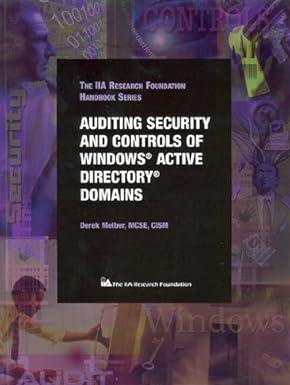Question
The business of Bagel Company Inc. increases dramatically when Bill begins delivering bagels and other baked goods to area universities and businesses for meetings and
The business of Bagel Company Inc. increases dramatically when Bill begins delivering bagels and other baked goods to area universities and businesses for meetings and other functions. Bill has also started selling gift cards and accepting credit cards and is collecting and remitting sales tax and calculating payroll, but is unsure how to account for everything so he asks you to take care of the following transactions for year 2.
Inventory purchases were made on account with Ingredients Company for the year totaled $180,000.
Store cash sales were $200,000; sales tax was collected and all but $1,050 was remitted to the appropriate government department.
Store credit card sales were $50,000; sales tax was collected and fully remitted by year end. The credit card companies remit payments directly into the companys bank account after deducting a fee of 2% of gross transactions.
The company sold $50,000 of gift cards for cash. By year end, $30,000 of the gift cards had been redeemed by customers.
$100,000 in sales on account were made evenly to JWU and to Citrin Cooperman.
The company prepaid its annual insurance premium of $6,000 that runs from July 1 to June 30; and incurred the following operating expenses on account: rent of $18,000; utilities of $14,000; and $4,200 for advertising.
Payments totaling $41,000 were received from credit sales (pro rata from each customer), net of $2,000 in sales discounts.
Employees earned total gross salaries of $100,000 of which $10,000 of federal taxes, $6,000 of RI tax and FICA (at a rate of 7.65%) were withheld. Employer matching FICA plus state unemployment tax of 2.35% was calculated. By year end, all payroll-related expenses and obligations were paid.
Payments totaling $220,000 from accounts payable were made. The year 1 income tax payable was paid.
Monthly payments were made on the note payable; payments were based on invoices received from the bank and mirrored a traditional loan amortization schedule.
Other:
A physical examination showed there was $78,000 of inventory remaining at year end.
Another years depreciation expense on the equipment should be recognized.
Based on past history, Bill estimates that 5% of sales on account would probably not be collected even with diligent collection efforts. Bill also tells you that he is sure that two of his customers with balances totaling $3,000 will definitely not be able to pay him.
Required:
Journalize the events and items above and prepare a multiple-step income statement and a classified balance sheet. Refer to the Week 1 Exercise final trial balance for beginning balances. The use of a worksheet similar to the Week 1 Exercise might prove helpful.
Compute the companys AR turnover and average days to collect receivables; Think about what Bill told you as written in item number 13 above. Write a memo explaining to Bill how the known and estimated uncollectible receivables must be accounted for and presented in the financial statements. Further explain the difference between the direct write-off and allowance methods and furnish Bill with your opinion on which method should be used for his business. Lastly, explain how an AR Aging report is compiled and what it is used for. How might the Company use an aging report to manage its collection activity?
Week 1 Exercise
| Trial Balance | Adjusting Entries | Adjusted Trial Balance | Income Statement | Closing Entries | Closed Trial Balance | ||||||||||||
| Account | DR | CR | DR | CR | DR | CR | DR | CR | DR | CR | DR | DR | |||||
| CASH | 38,000 | 38,000 | |||||||||||||||
| A/R | 20,000 | 20,000 | |||||||||||||||
| INVENTORY | 30,000 | 30,000 | |||||||||||||||
| EQUIP | 40,000 | 40,000 | |||||||||||||||
| ACCUM DEPREC | 3,500 | 3,500 | |||||||||||||||
| A/P | 20,000 | 20,000 | |||||||||||||||
| INCOME TAX PAY. | 6,500 | ||||||||||||||||
| N/P | 60,000 | 60,000 | |||||||||||||||
| C/S | 20,000 | 20,000 | |||||||||||||||
| DISTRIBUTION | 8,000 | 8,000 | |||||||||||||||
| SALES | 220,000 | 220,000 | 220,000 | ||||||||||||||
| PURCHASES | 100,000 | 100,000 | 100,000 | ||||||||||||||
| INVENTORY ADJ | 30,000 | 30,000 | - | 30,000 | |||||||||||||
| PAYROLL EXP | 80,000 | 80,000 | 80,000 | ||||||||||||||
| PAYROLL TAX EXP | 8,000 | 8,000 | 8,000 | ||||||||||||||
| RENT EXP | 12,000 | 12,000 | 12,000 | ||||||||||||||
| INSURANCE EXP | 3,600 | 3,600 | 3,600 | ||||||||||||||
| UTIL EXP | 8,000 | 8,000 | 8,000 | ||||||||||||||
| ADVERT EXP | 2,400 | 2,400 | 2,400 | ||||||||||||||
| DEPREC EXP | 3,500 | 3,500 | 3,500 | ||||||||||||||
| INCOME TAX EXP | 6,500 | ||||||||||||||||
| Totals | $ 320,000 | $ 320,000 | $ 33,500 | $ 33,500 | $ 360,000 | $ 360,000 | EBT | $ 32,500 | |||||||||
| Income Tax Exp. | 6,500 | ||||||||||||||||
| Net Income | $ 26,000 | ||||||||||||||||
Step by Step Solution
There are 3 Steps involved in it
Step: 1

Get Instant Access to Expert-Tailored Solutions
See step-by-step solutions with expert insights and AI powered tools for academic success
Step: 2

Step: 3

Ace Your Homework with AI
Get the answers you need in no time with our AI-driven, step-by-step assistance
Get Started


